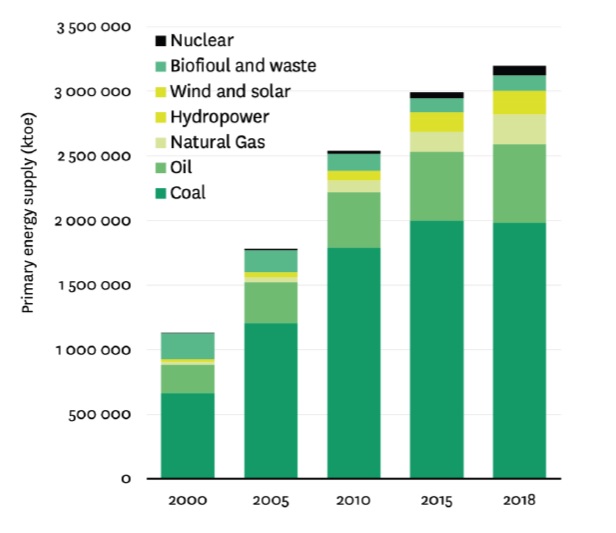Hybrid energy storage: A flexible and strategic component of Europe’s energy transition – Innovation News Network

Report on Hybrid Energy Storage Systems and their Contribution to Sustainable Development Goals
This report outlines the critical role of Hybrid Energy Storage Systems (HESS) in meeting Europe’s complex energy needs, with a significant focus on their alignment with the United Nations’ Sustainable Development Goals (SDGs). Analysis is based on insights from Spyridon Pantelis, Project Manager at the European Energy Research Alliance.
Advancing the Sustainable Development Agenda through Hybrid Energy Storage
The transition to climate neutrality necessitates advanced energy solutions. HESS, which combine multiple storage technologies, are emerging as a pivotal technology for ensuring system stability and efficiency, directly contributing to several key SDGs.
SDG 7: Affordable and Clean Energy
HESS are fundamental to achieving SDG 7 by facilitating the large-scale integration of variable renewable energy sources. Conventional single-technology systems are often insufficient for managing the complex demands of a decentralized, renewables-based power grid. By combining technologies such as batteries, supercapacitors, hydrogen, and thermal storage, HESS provide a versatile solution to ensure a stable and reliable supply of clean energy.
- Grid Stability: HESS deliver both short- and long-duration services, including frequency regulation and backup power, which are essential for grid stability as the share of renewables increases.
- Energy Access: In remote and islanded communities, HESS enhance energy autonomy and reliability, improving access to clean energy where grid infrastructure is weak or non-existent.
SDG 9: Industry, Innovation, and Infrastructure
The development and deployment of HESS stimulate progress toward SDG 9 by fostering innovation, creating industrial opportunities, and building resilient infrastructure.
- Technological Innovation: HESS represent a significant innovation, leveraging the complementary characteristics of different storage technologies to create a more effective and flexible system.
- Industrial Competitiveness: As noted in policy frameworks like the Net-Zero Industry Act, developing domestic capabilities in clean technologies such as HESS is vital for economic competitiveness and reducing external dependencies. This engages multiple industrial domains, from materials science to digital controls.
- Resilient Infrastructure: By providing layered flexibility and faster response times, HESS improve the robustness of energy grids against volatility and disruptions, as highlighted by events like the 2025 blackout in the Iberian Peninsula.
SDG 11 (Sustainable Cities and Communities) & SDG 12 (Responsible Consumption and Production)
HESS directly support the creation of sustainable cities and promote responsible production patterns by enabling efficient energy management across various sectors.
- Built Environment: In buildings and district energy networks, combining battery and thermal storage allows for effective load management and demand-side flexibility, contributing to more sustainable urban energy systems (SDG 11).
- Sustainable Transport: HESS support the infrastructure for electromobility, from fast-charging stations using supercapacitor-battery hybrids to hydrogen storage for long-haul transport (SDG 11).
- Industrial Decarbonisation: In industrial settings, HESS enhance process efficiency, manage peak loads, and facilitate the integration of renewable energy, promoting decarbonisation and more sustainable production methods (SDG 12).
SDG 13: Climate Action
The primary function of HESS is to enable the deep decarbonisation required to meet the objectives of SDG 13. By overcoming the intermittency of solar and wind power, HESS are a critical enabler of the energy transition and a key tool in mitigating climate change.
These systems reduce reliance on fossil fuels for grid balancing and backup power, directly lowering greenhouse gas emissions and supporting strategic goals like those outlined in the REPowerEU plan.
Implementation Challenges and Strategic Pathways
Despite their potential, the widespread adoption of HESS faces several barriers that require concerted action from policymakers, industry, and the research community.
Current Barriers to Deployment
- Lack of standardisation across different hybrid configurations.
- Limited data on the real-world performance and lifecycle of integrated systems.
- Financing models that fail to capture the full value stack of HESS.
- Technical challenges related to control systems, interoperability, and system integration.
Policy and Research Recommendations
To accelerate HESS deployment, a supportive ecosystem is required. Recent policy initiatives, including market design reform and the Net-Zero Industry Act, are positive steps. However, continued focus is needed.
Strategic guidance is available through resources developed by the StoRIES project, which provides a framework for future action:
- The Technology Roadmap for Hybridisation of Energy Storage: This document outlines key technical challenges, integration strategies, and use cases to guide development.
- The Strategic Research and Innovation Agenda (SRIA): This agenda identifies priority R&D areas, enabling regulatory frameworks, and funding mechanisms to support stakeholders.
These resources are essential for aligning efforts across research, industry, and policy to unlock the full potential of HESS in service of the Sustainable Development Goals.
Analysis of Sustainable Development Goals in the Article
1. Which SDGs are addressed or connected to the issues highlighted in the article?
The article on hybrid energy storage systems (HESS) addresses several Sustainable Development Goals (SDGs) by focusing on the transition to clean energy, industrial innovation, and building resilient infrastructure. The primary SDGs connected to the article’s content are:
- SDG 7: Affordable and Clean Energy: The core theme is ensuring stable and efficient energy systems by integrating renewable energy sources, which is central to SDG 7. The article states that “energy storage is becoming a critical element in maintaining energy system stability and efficiency” as Europe moves toward high shares of variable renewables.
- SDG 9: Industry, Innovation, and Infrastructure: The article highlights HESS as a key innovation for upgrading energy infrastructure. It discusses the “industrial opportunities” presented by HESS, the need to strengthen “clean technology capabilities,” and the role of policy frameworks like the “Net-Zero Industry Act” in promoting sustainable industrial development and resilient infrastructure.
- SDG 11: Sustainable Cities and Communities: The text connects HESS to urban and community resilience. It mentions applications in the “built environment and district energy,” support for “electromobility and transport,” and improving system reliability in “remote and islanded systems,” all of which contribute to making human settlements more sustainable and resilient.
- SDG 13: Climate Action: The entire discussion is framed within the context of Europe’s goal of achieving “climate neutrality.” HESS is presented as a crucial technology to enable the large-scale deployment of renewable energy, which is a primary strategy for combating climate change and its impacts.
2. What specific targets under those SDGs can be identified based on the article’s content?
Based on the article’s discussion of HESS, several specific SDG targets can be identified:
- Target 7.2: Increase substantially the share of renewable energy in the global energy mix.
- The article directly supports this target by explaining that HESS is necessary to manage a “power system with high shares of variable renewable energy sources.” It also notes that “by 2030, more than half of Europe’s electricity is expected to come from variable sources,” and HESS is a key enabler for this transition.
- Target 7.a: Enhance international cooperation to facilitate access to clean energy research and technology… and promote investment in energy infrastructure and clean energy technology.
- The article mentions the “StoRIES project,” the “European Energy Research Alliance,” and the development of a “Technology Roadmap” and “Strategic Research and Innovation Agenda” (SRIA). These are clear examples of collaborative efforts to advance clean energy technology (HESS) and guide investment.
- Target 9.4: Upgrade infrastructure and retrofit industries to make them sustainable, with increased resource-use efficiency and greater adoption of clean and environmentally sound technologies.
- The article describes how HESS can “facilitate decarbonisation” in “industrial energy systems” and enhance “process efficiency.” The promotion of HESS under the “Net-Zero Industry Act” is a direct effort to upgrade infrastructure with clean technology.
- Target 9.5: Enhance scientific research, upgrade the technological capabilities of industrial sectors… encouraging innovation.
- The focus on HESS as an innovative solution, the mention of “active areas of research” (control systems, interoperability), and the creation of the SRIA to identify “priority R&D areas” all point directly to this target.
- Target 11.2: Provide access to safe, affordable, accessible and sustainable transport systems for all.
- The article identifies “electromobility and transport” as a key application area for HESS, noting its ability to support “fast-charging” and “long-haul or maritime applications,” thereby contributing to the development of sustainable transport infrastructure.
- Target 13.2: Integrate climate change measures into national policies, strategies and planning.
- The article frames the need for HESS within Europe’s overarching goal of “climate neutrality.” It references specific policies like the “Net-Zero Industry Act,” the “Clean Industrial Deal,” and the “REPowerEU strategy,” which are all strategic plans integrating climate change measures.
3. Are there any indicators mentioned or implied in the article that can be used to measure progress towards the identified targets?
The article implies several indicators that can be used to measure progress towards the identified targets, even if it does not cite official SDG indicator codes:
- Share of renewable energy: The article provides a clear, measurable indicator for Target 7.2 by stating, “By 2030, more than half of Europe’s electricity is expected to come from variable sources.” This percentage serves as a direct metric of progress.
- Investment in clean energy R&D and technology: For Target 7.a and 9.5, the existence and funding of initiatives like the “StoRIES project” and the implementation of its “Strategic Research and Innovation Agenda” can be used as an indicator of investment and international cooperation in clean energy research.
- Development of strategic clean technologies: The article points to the development and deployment of HESS as a metric for Target 9.4. Progress could be measured by the manufacturing capacity for HESS components and the number of industrial and grid-scale installations, as promoted by the “Net-Zero Industry Act.”
- Adoption of sustainable transport infrastructure: For Target 11.2, an implied indicator is the number of fast-charging stations for electric vehicles and the development of hydrogen-based storage for long-haul transport, which the article states HESS can support.
- Integration of climate policies: For Target 13.2, the enactment and implementation of policies mentioned in the article, such as the “Net-Zero Industry Act” and the “REPowerEU strategy,” serve as a direct indicator of countries integrating climate change measures into their planning.
- System resilience and reduction of blackouts: An implied indicator for infrastructure resilience (part of SDG 9 and 11) is the frequency and impact of grid failures. The article mentions the “2025 blackout in the Iberian Peninsula” as a problem that HESS can help mitigate, suggesting that a reduction in such events would indicate improved system robustness.
4. Summary of SDGs, Targets, and Indicators
| SDGs | Targets | Indicators (Mentioned or Implied in the Article) |
|---|---|---|
| SDG 7: Affordable and Clean Energy | 7.2: Increase substantially the share of renewable energy in the global energy mix. | The share of electricity from variable renewable sources, with the article citing a goal of “more than half of Europe’s electricity” by 2030. |
| SDG 9: Industry, Innovation, and Infrastructure | 9.4: Upgrade infrastructure and retrofit industries to make them sustainable… with greater adoption of clean… technologies. | Deployment of HESS in industrial systems to facilitate decarbonisation; expansion of domestic manufacturing capacity for clean technologies under the Net-Zero Industry Act. |
| 9.5: Enhance scientific research, upgrade the technological capabilities… encouraging innovation. | Implementation of the Strategic Research and Innovation Agenda (SRIA) and Technology Roadmap for HESS; investment in R&D for control systems and interoperability. | |
| SDG 11: Sustainable Cities and Communities | 11.2: Provide access to… sustainable transport systems for all. | Development of HESS-supported infrastructure for electromobility, such as fast-charging stations and hydrogen storage for transport. |
| SDG 13: Climate Action | 13.2: Integrate climate change measures into national policies, strategies and planning. | The implementation of strategic policies like the Net-Zero Industry Act and the REPowerEU strategy to achieve climate neutrality. |
Source: innovationnewsnetwork.com

What is Your Reaction?
 Like
0
Like
0
 Dislike
0
Dislike
0
 Love
0
Love
0
 Funny
0
Funny
0
 Angry
0
Angry
0
 Sad
0
Sad
0
 Wow
0
Wow
0











































































